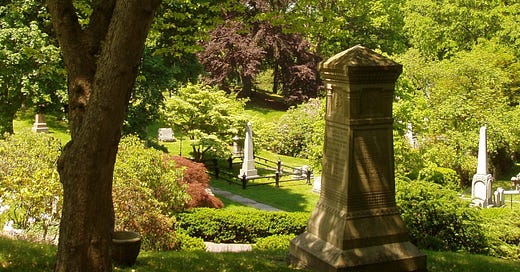I love a story about graveyards and parrots! What’s not to like? In the March 5th issue of the New York Time’s Sunday Magazine, Joe Kloc wrote a lovely piece about Green-Wood Cemetery. One one level the story is about a visit with with Steve Baldwin, known to some as “the Parrot Guy,” because he has unofficially kept watch over the city’s flock of South American green monk parakeets, many of whom choose to live in the cemetery because it is a protected space. But the parrots aren’t really the point — the piece is a lyrical essay about the stories old graves offer us and the power of cemeteries to remind us of what has come before and what we might want to leave behind.
Joe Kloc put it this way, when reflecting on Baldwin’s description of the cemetery as a library of completed lives: “I think I’m beginning to see what he means: a place to take stock of all the books on out-of-reach shelves and imagine the adventures they contain, before going off to have our own.”
I’ve also found graveyards to be contemplative and inspiring places, especially the old ones, like Mount Auburn Cemetery in Cambridge Massachusetts, a place deliberately built in 1831 to invite the living in, rather than simply a place to warehouse the dead.
An afternoon exploring an old graveyard invites you to (even if just for one moment) understand your own death as a completely normal process, one that has gone on forever and will continue to go on long after you die. There’s something so comforting about the epitaphs, the gravestones, the trees, the quiet and the space.
To consider each life honored at a cemetery as one of many stories that will one day include your own is to reframe that place—from a place of loss to a place of continuity, a place of connection, a place of possibility. What kind of epitaph would you want on your grave? (I’d love to know, please post in the comments.)
There’s something luxuriously archaic about a graveyard. These days, more than half of us choose to be cremated, rather than buried, our ashes scattered, leaving no trace behind. While many people choose cremation out of a desire to be environmentally sensitive, it turns out that the incineration of bodies uses a lot of fossil fuel and the incineration process spreads the toxins our bodies contain to the atmosphere, to fall, elsewhere with the rain.
Cemeteries offer us, the living, a physical space to mourn our losses and honor our dead. Maybe, I’ve come to believe, we still need what they have to offer us. I’m not alone in this, and I’ll be writing more about this in future newsletters.
For now, let me offer you this thought: if you want to be buried without the embalming fluid, the grave vaults designed to keep a cemetery even and green, and the hoopla and expense surrounding modern American burial, you can. It’s called ‘green burial’ and 60% of people surveyed by the National Funderal Directors Association would be interested in it.
To learn more, please listen to my podcast episode with Elizabeth Fournier, the founder of Cornerstone Funeral Services, and the author of the Green Burial Guidebook (otherwise known as the Green Reaper): at lifedeathlaw.com. Here’s a link to the episode: https://www.lifedeathlaw.com/episodes/greenburial.




